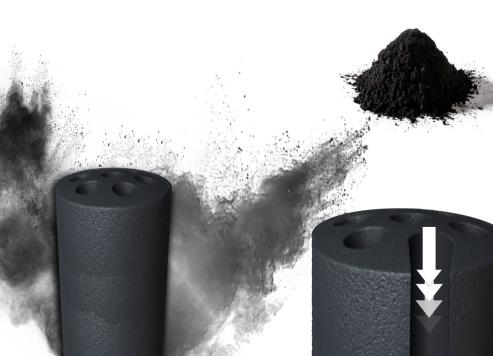CSIC, in collaboration with the University Nacional de Colombia and University of Seville, has
developed a procedure that, through the design and manufacture of extruder molds with 3D printing,
enables to obtain integral carbon monoliths of different geometric shapes and with defined and
controlled surface properties. The carbon monoliths thus obtained can be used, effectively and as an
alternative to alumina and silica, as supports for solid-base catalytic reactions.
Industrial partners are sought to collaborate through a patent licence agreement.
An offer for Patent Licensing
Description of the technology
The integral carbon monoliths thus obtained are extremely useful in processes that involve solid- basic catalytic reactions, such as, the control of environmental contamination, the selective hydrogenation of NOX, the catalyzed oxidation of volatile organic compounds and the biodiesel synthesis and methane reforming.
Carbon monoliths are developed from particles and binders in order to shape united and compact structures. The main use of this type of carbonaceous materials has been as an adsorbent in processes such as the control of environmental pollution and water purification.
Carbonaceous materials are an interesting bet to be used as adsorbents for properties such as, among others, their high thermal resistance in an inert atmosphere and to acidic or alkaline media and for presenting the possibility of modifying their structure at the meso, micro and / or nano levels that enables us to manipulate its surface chemistry and, thereby, generate, in a controlled manner, solids of different porosity and surface area.
The present invention allows, by means of 3D printing, to obtain carbon monoliths, from carbonaceous materials of different nature, with defined and controlled surface properties.
The use of carbonaceous materials of different nature together with the subsequent addition of a synthetic polymer under hydrophilic, hydrophobic and / or amphoteric conditions makes the monoliths obtaining process hereby presented versatile and that may be designed according to the catalytic reaction where is intended to be applied.
Main innovations and advantages
· The procedure generates reproducibility in the synthesis of integralcarbon monoliths, allowing to obtaining structured materials withtotally defined geometries and that preserve the properties of thecarbonaceous source.
· The procedure enables the possibility of using carbonaceous materialsof different nature.
· The use of 3D printing in the design and manufacture of extrudermolds allows obtaining multiple geometries
· It is a low cost synthesis procedure
· The activation and extrusion stages, required steps in most carbonmonolith manufacturing processes, are not necessary in the developedmethod.






